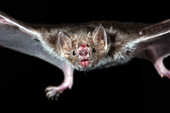
Georgia Broadens Bat Researches Regarding Virus Transmission
By Tea Mariamidze
Tuesday, September 18
Georgia has broadened researches on bats in terms of bat-borne viruses that are transmitted to humans. However, nothing dangerous has been revealed yet.
The statement was made by Paata Imnadze, Head of the Scientific Board of Disease Control of Georgia.
According to him, more and more attention has been paid to the causal links of animals, environmental factors and human health.
“Surveys on bats have been intensified everywhere, as bats were found to be potential transmitters of diseases to humans. Georgia actively got involved in the World Consortium, which will actively study bats and pathogens that can be in their bodies,” Imnadze said.
A four-day conference was opened in Tbilisi on September 17 to discuss risks of zoonotic diseases caused by bats in Asia.
As Imnadze explains, the West Asia Network has been established, where Georgia is on the leading position.
“Representatives of 10 countries have arrived and we will discuss the network of the surveillance on bats. It is especially pleasing that during the last two days the conference will move to the center of Lugar laboratory,” he added.
The Head of the Scientific Board of Disease Control of Georgia noted that Lugar laboratory has many times been slammed by the Russian mass media which alleged the laboratory is used for creating various viruses. According to him, everyone will see that the lab serves the welfare of the population.
A bat-borne virus is any virus whose primary reservoir is any species of bat. Bat-borne viruses are among the most important of the emerging viruses. They are transmitted via bat bite and transfer via saliva, as well as aerosolization of saliva, feces, and/or urine. Like rabies virus, newly emerging bat-borne viruses can be transmitted to humans directly by bats. These include the Ebola virus, SARS, and the Middle East respiratory syndrome coronavirus.
The scientists assure that bats harbor more viruses than rodents and are capable of spreading disease over a wider geographic area owing to their ability to fly and their migration and roosting patterns.


